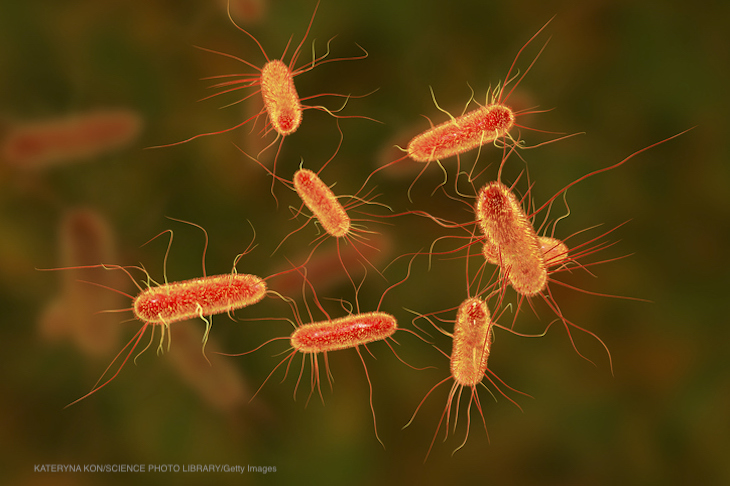Every time there is an outbreak and the cause or pathogen is not immediately apparent, investigators have several clues they can use to help them solve it. One is the incubation period, of the time between when a person eats contaminated food and they start getting sick. These facts are complicated by the fact that most people think the last thing they ate made them sick, which is often not the case. What are common food poisoning pathogen incubation periods?

All pathogens have different incubation periods that can range from hours to days or even weeks and months. While there is always a range, these incubation periods are true across all outbreaks.
Common Food Poisoning Pathogen Incubation Periods
Bacillus cereus can cause illness especially in foods that have been sitting out too long at room temperature. This pathogen has sickened people who have eaten leftovers, sauces, soups, and rice and is often linked to catering and restaurant outbreaks. The incubation period for vomiting is usually 30 minutes to 6 hours, and the incubation period for diarrhea is 6 to 15 hours. Most people are sick for about 24 hours and most people do not require medical attention to recover.
Botulism is a potent toxin that can kill adults in tiny amounts. It is produced by the Clostridium botulinum spore under anaerobic conditions, such as canned low acid meats and vegetables. People start experiencing symptoms, which include double vision, blurred vision, drooping eyelids, difficulty swallowing, and muscle weakness, in 18 to 36 hours. This infection is a medical emergency.
Campylobacter usually contaminates chicken, shellfish, unpasteurized milk, and turkey. Symptoms of this infection, which include diarrhea, cramps, fever, and vomiting, usually begin two to five days after infection and most people are sick for about a week. Complications from campylobacter infections can include Guillain-Barré syndrome, which can lead to paralysis.
Clostridium perfringens is another pathogen that typically causes outbreaks in catering and restaurant situations. Most people get sick within 6 to 24 hours with symptoms of diarrhea and stomach cramps, and the illness usually lasts less than 24 hours.
E. coli bacteria can cause serious illness, especially among young children. It often contaminates ground beef, unpasteurized milk and juice, soft cheeses made from raw milk, and raw produce such as romaine lettuce and leafy greens. Most people get sick within three to four days, but the range can be from one to 10 days. Symptoms include severe abdominal cramps and bloody diarrhea. Hemolytic uremic syndrome (HUS), a type of kidney failure, can develop within a week or two.
Hepatitis A virus is easily passed person to person, but it can also contaminated raw or undercooked shellfish, raw produce, and uncooked foods. The incubation period is around 28 days, with a range of 15 to 50 days. People suffer from jaundice, fever, fatigue, diarrhea, join pain, and loss of appetite.
Listeria monocytogenes is a dangerous and potentially deadly pathogen that usually hospitalizes a large proportion of patients. People who are most susceptible to serious complications from this infection include the elderly, pregnant women, the very young, and anyone with a chronic health condition. Symptoms usually appear within one to four weeks, but the incubation period can be as long as 70 days. People suffer from headache, stiff neck, confusion, fever, and muscle aches. These outbreaks have been linked to leafy greens, raw milk, soft cheeses, and deli meats.
Norovirus usually causes outbreaks in restaurants, since the virus is very contagious. People get sick within 12 to 48 hours and suffer from diarrhea, vomiting, nausea, and stomach pain. Most people get better within a few days without medical attention.
Salmonella is a common pathogen that usually contaminates chicken, beef, sprouts, nuts and nut butters, egg, pork, and produce. The incubation period is from six hours to six days and people suffer from diarrhea, fever, stomach cramps, and vomiting. Usually about 20% of patients in these outbreaks are hospitalized.
Shigella is a bacteria that usually causes illnesses at water venues such as splash pads and water parks, but can also be caused by sick food handlers. The incubation period is from one to seven days, although most people start feeling sick within a day or two. Symptoms include sudden cramps, fever, diarrhea that may be bloody, and feeling the need to pass stool even when the bowel is empty.
Staphylococcus aureus is a pathogen that grows in foods that are not cooked after handling, such as sliced meats, sandwiches, and pastries. The bacteria is found on the skin. The incubation period for this infection is from 30 minutes to eight hours. People develop sudden nausea, vomiting, stomach cramps, and diarrhea.
Vibrio is most commonly associated with raw or undercooked shellfish, especially oysters, since it is found in brackish water. Symptoms, which include diarrhea, vomiting, and abdominal pain, appear within two to 48 hours.
How to Protect Yourself
While it can be difficult for a patient to determine what exactly made them sick, since most people think the last thing they ate caused their illness, if you know more about the mechanisms of food poisoning, you may be able to help yourself and give your doctor more information to aid in your diagnosis.
Know the symptoms of foodborne illnesses and always follow safe food preparation and handling rules, especially if someone in your household is at high risk for complications from food poisoning.




